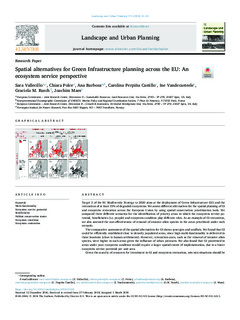| dc.contributor.author | Vallecillo, Sara | |
| dc.contributor.author | Polce, Chiara | |
| dc.contributor.author | Barbosa, Ana | |
| dc.contributor.author | Castillo, Carolina Perpiña | |
| dc.contributor.author | Vandecasteele, Ine | |
| dc.contributor.author | Rusch, Graciela | |
| dc.contributor.author | Maes, Joachim | |
| dc.coverage.spatial | Europe | nb_NO |
| dc.date.accessioned | 2018-03-23T09:32:19Z | |
| dc.date.available | 2018-03-23T09:32:19Z | |
| dc.date.created | 2018-03-14T14:23:14Z | |
| dc.date.issued | 2018 | |
| dc.identifier.citation | Landscape and Urban Planning. 2018, 174 41-54. | nb_NO |
| dc.identifier.issn | 0169-2046 | |
| dc.identifier.uri | http://hdl.handle.net/11250/2491840 | |
| dc.description.abstract | Target 2 of the EU Biodiversity Strategy to 2020 aims at the deployment of Green Infrastructure (GI) and the restoration of at least 15% of degraded ecosystems. We assess different alternatives for the spatial planning of GI and ecosystem restoration across the European Union by using spatial conservation prioritization tools. We compared three different scenarios for the identification of priority areas in which the ecosystem service potential, beneficiaries (i.e. people) and ecosystem condition play different roles. As an example of GI restoration, we also assessed the cost-effectiveness of removal of invasive alien species in the areas prioritized under each scenario. The comparative assessment of the spatial alternatives for GI shows synergies and conflicts. We found that GI could be efficiently established close to densely populated areas, since high multi-functionality is delivered in these locations (close to human settlements). However, restoration costs, such as the removal of invasive alien species, were higher in such areas given the influence of urban pressures. We also found that GI prioritized in areas under poor ecosystem condition would require a larger spatial extent of implementation, due to a lower ecosystem service potential per unit area. Given the scarcity of resources for investment in GI and ecosystem restoration, win-win situations should be identified where GI designation can deliver several policy objectives simultaneously. The prioritization framework we have presented here could also be applied at the country or regional level to support local planning. Multi-functionality Ecosystem service potential Beneficiaries Habitat conservation status Ecosystem condition Ecosystem restoration | nb_NO |
| dc.language.iso | eng | nb_NO |
| dc.rights | Attribution-NonCommercial-NoDerivatives 4.0 Internasjonal | * |
| dc.rights.uri | http://creativecommons.org/licenses/by-nc-nd/4.0/deed.no | * |
| dc.subject | Multi-functionality | nb_NO |
| dc.subject | Ecosystem service potential | nb_NO |
| dc.subject | Beneficiaries | nb_NO |
| dc.subject | Habitat conservation status | nb_NO |
| dc.subject | Ecosystem condition | nb_NO |
| dc.subject | Ecosystem restoration | nb_NO |
| dc.title | Spatial alternatives for Green Infrastructure planning across the EU: An ecosystem service perspective | nb_NO |
| dc.type | Journal article | nb_NO |
| dc.type | Peer reviewed | nb_NO |
| dc.description.version | publishedVersion | nb_NO |
| dc.subject.nsi | VDP::Zoologiske og botaniske fag: 480 | nb_NO |
| dc.subject.nsi | VDP::Zoology and botany: 480 | nb_NO |
| dc.source.pagenumber | 41-54 | nb_NO |
| dc.source.volume | 174 | nb_NO |
| dc.source.journal | Landscape and Urban Planning | nb_NO |
| dc.identifier.doi | 10.1016/j.landurbplan.2018.03.001 | |
| dc.identifier.cristin | 1572829 | |
| dc.relation.project | EC/FP7/OpenNESS (Grant agreement no. 308428) | nb_NO |
| cristin.unitcode | 7511,2,0,0 | |
| cristin.unitname | Avdeling for terrestrisk økologi | |
| cristin.ispublished | true | |
| cristin.fulltext | original | |
| cristin.qualitycode | 2 | |

